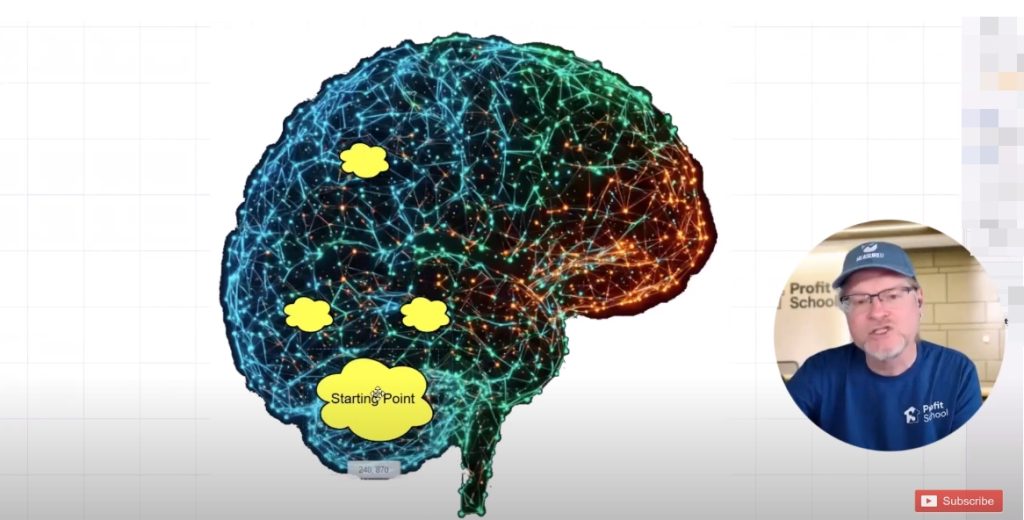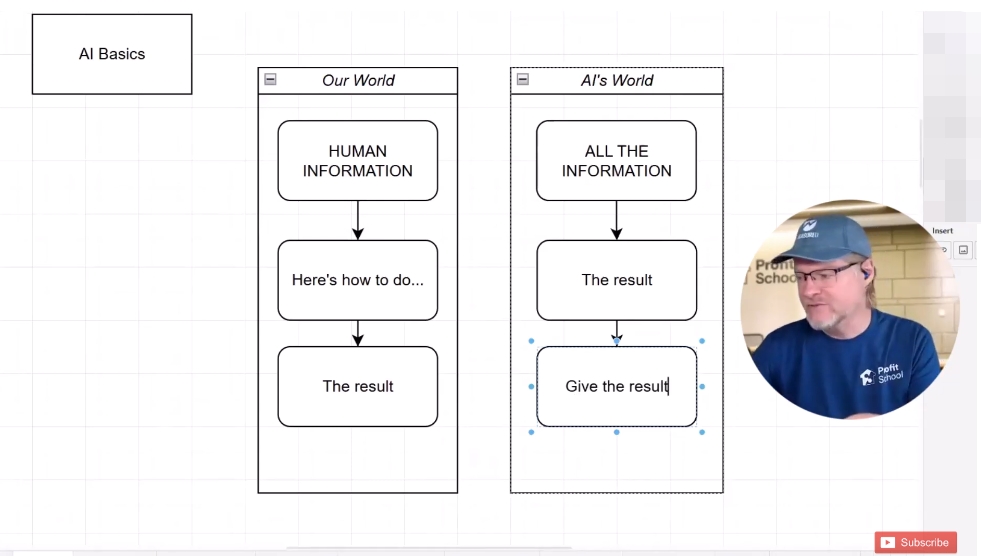Tired of feeling like you're wrestling with AI, constantly tweaking prompts but not getting the results you hoped for? That’s because you and I learned to approach AI with a micromanagement mindset, controlling every step of the way.
That changed when my business partner Mercer showed me how he interacts with AI. In this post, you'll discover the key insights from an AI team training he delivered (you can watch an excerpt below).
Stick with me and learn why letting go of the control freak in you while using AI is crucial, leads to more creative and better outputs, and frees up your time for more important things than trying to write perfect prompts.
Watch how to get great results from AI by treating it differently
In this eye-opening segment from an AI training, Mercer shares his innovative perspective on how to truly partner with AI. You’ll discover tons of inspiring examples of prompts to get the outcomes you want.
Key takeaways
- Increased efficiency: Let AI handle the “how” and you'll free up your own time, plus get better outputs.
- More creative solutions: Dare to give AI autonomy and you may get surprising ideas and solutions.
- Faster turnaround times: Ditch your outdated prompting habit and you'll complete tasks and projects faster.
- Reduced frustration: Shift to a more trusting relationship with your AI “partner” and get a nicer and more productive experience.
- Watch how to get great results from AI by treating it differently
- Key takeaways
- Step 1: Understand the AI brain (before you write your next prompt)
- Step 2: Stop telling AI how to do things
- Step 3: Use AI hallucinations to your advantage
- Step 4: Establish a human-AI partnership
- Answers to common questions about getting better AI outputs
- Your AI implementation plan to get better results from AI
Step 1: Understand the AI brain (before you write your next prompt)
Many of us still expect AI to understand and respond like a person.
But as Mercer explains in his AI training:
- AI uses a massive amount of information and processes it differently than humans.
- We, humans, are limited by our experiences and memories.

AI isn't just a faster human. It's a fundamentally different kind of intelligence.
In his training, Mercer uses the analogy of asking a chef for a dish. You wouldn't dictate every single chop and stir; instead, you'd trust their expertise to prepare a delicious meal for you.
After reframing your mindset to appreciate AI's unique capabilities, the next step is to actually let it work!
Step 2: Stop telling AI how to do things
Constantly looking over someone's shoulder rarely leads to their best work. The same goes for micromanaging AI.
In the training, and this recording of a Gemini workshop, Mercer gives tons of examples.
I picked one to show what micromanaging looks like in practice.
Example of the old prompting way versus the new and effective technique
AI is evolving fast. A lot of the information and advice you come across is already outdated.
Without realizing it, you are, for example, writing a…
Bad prompt to write a blog post
"Write a 500-word blog post about the benefits of using AI for marketing, with an introduction, three specific benefits as headings, and a conclusion that includes a call to action to sign up for our newsletter"Here is a prompt that will give you a much better output:
Good prompt to write blog posts
“Create a compelling blog post for marketing professionals explaining the key advantages of using AI in their work. The goal is to inform and encourage them to learn more about our AI-powered marketing solutions.”Notice the difference?
The second prompt focuses on the objective, audience, and desired outcome.
This gives AI the freedom to determine the best structure, highlight the most relevant benefits, and choose the most persuasive language.
And that is the next key insight from Mercer’ training:
Write your prompts for the results you want
Shift from telling AI how to do something to telling it what you want to achieve.
That is essentially reversing the typical human approach to instruction.
To further guide AI effectively without micromanaging, consider these tips based on Mercer's insights:
- Clearly define the desired result: What is the ultimate goal of this task?
- Provide context: Give AI any relevant background information or brand guidelines. You can also use Notebook LM to build your business knowledge hub.
- Specify the format: Do you need a blog post, an email, a social media caption?
- Define the audience: Who are you trying to reach?
- Ask open-ended questions: Encourage AI to suggest ideas and approaches.
“Incredible things happen when we trust AI and give it the autonomy that it deserves with our prompting” – Mercer

As a side-note, long before AI took over, we applied this very principle within our team to get the best possible results:
“Trust, But Verify (TBV)”
Despite all the new possibilities AI offers for businesses, that core principle stood the test of time…
Step 3: Use AI hallucinations to your advantage
One of the biggest fears people have about AI is that it ‘makes things up'. You know, the so-called hallucinations.
But in his training, Mercer makes an important point: hallucinations aren't always a bad thing. (And humans also make mistakes).
Leverage unexpected AI outcomes (where possible)
There is a difference between a useless fabrication and a potentially brilliant, out-of-the-box idea.
Instead of viewing every mistake AI makes as an error to be eradicated, adopt an editing mindset.
Example: The Creative Spark of an AI “Hallucination”
Imagine you ask AI to brainstorm marketing slogans for a new eco-friendly product.
It might come up with something completely unexpected, perhaps even a bit nonsensical at first glance.
However, within that “hallucination” might be the seed of a truly unique and memorable concept that you would never have thought of on your own .
How to approach AI hallucinations?
To deal with AI’s creative leaps that bypass our own logical thinking, you can best apply Mercer’s key takeaways from his training:
- Fact-check rigorously: Always verify any factual claims made by AI.
- Evaluate for relevance: Does the output align with your objectives and target audience?
- Look for unexpected gems: Are there any surprising or novel ideas that could be valuable, even if they weren't what you initially expected?
- Provide feedback: If something is clearly wrong or off-track, give AI specific feedback to help it learn and improve.
When you do this systematically, you will be ready for your next step…
Step 4: Establish a human-AI partnership
As Mercer highlights, we need to shift from viewing AI as a tool that needs to be controlled to a valuable collaborator with unique strengths.
But how do you do that?
Simple.
Give AI feedback and start communicating instead of prompting
Just like any good collaboration, the relationship with AI thrives on communication and refinement.
This means that you need to
- Actively engage with AI's output
- Provide constructive feedback
- Iterate on the results until you achieve your desired outcome
The iterative process – prompt, review, feedback, refine – is where the true magic of the human-AI partnership happens.
Example of iterative refinement prompting
Imagine you've asked AI to write a product description. The first draft might be good, but perhaps it's not quite hitting the right tone or emphasizing the key benefits you want to highlight.
Instead of rewriting it yourself from scratch or trying to come up with a better prompt, provide specific feedback to the AI.
Here is an example:
"This is a good start, but could you make the tone more enthusiastic and really emphasize the product's durability and ease of use?"This way, you guide the AI to refine its output in a way that aligns with your human understanding and expertise.
How to foster a collaborative relationship with AI?
Again, I refer to the insights Mercer shared in the training (and which you can watch in the video on the top of this page):
- Think of AI as a brainstorming partner: Use it to generate initial ideas and explore different angles.
- Provide specific and actionable feedback: Don't just say “This isn't good.” Explain why and suggest how it could be improved.
- Be open to AI's suggestions: Sometimes, AI will propose ideas you hadn't considered, which can lead to better outcomes.
- Recognize the human role in quality control: Your expertise and judgment are still essential for ensuring accuracy, brand consistency, and overall quality.
If you embrace this collaborative approach, you combine the best of the two worlds.
Human creativity, critical thinking, and domain expertise. AI’s vast knowledge and processing power.
That leads to results that are greater than the sum of their parts.
Answers to common questions about getting better AI outputs
What exactly does it mean to micromanage AI?
Micromanaging AI involves constantly monitoring and controlling its process, dictating every step, and not allowing it the flexibility to leverage its own knowledge and processing power. It's like providing overly detailed instructions for every sub-task instead of focusing on the desired outcome.
What should I do when AI produces “hallucinations” or incorrect information?
Don't view hallucinations as a reason to over-control. Instead, focus on editing and fact-checking AI-generated content. Sometimes, these unexpected outputs can even lead to creative solutions you hadn't considered. The human role in quality control is still crucial.
How is working with AI differently from working with a human team member?
While both require collaboration, AI has access to a much larger pool of information and processes it differently than humans. Treating AI like a human you need to constantly direct can limit its unique strengths. Instead, focus on clearly communicating the desired outcome and allowing AI to leverage its capabilities.
Your AI implementation plan to get better results from AI
To begin implementing these changes, focus on a specific task or project where you currently use AI.
- Identify a task: Choose a current project or task where you use AI.
- Define the desired result: Clearly articulate the outcome you want to achieve.
- Prompt for the result: Instead of dictating the steps, ask AI how it would approach the task to achieve that result.
- Review and provide feedback: Analyze the output, focusing on the quality and alignment with your goal. Give specific feedback for refinement.
- Iterate and observe: Continue to collaborate with AI, providing feedback and observing the improvements in efficiency and the quality of the results.
If you want to dive deeper and get even more advanced tips from Mercer, make sure you watch his Gemini AI workshop.
